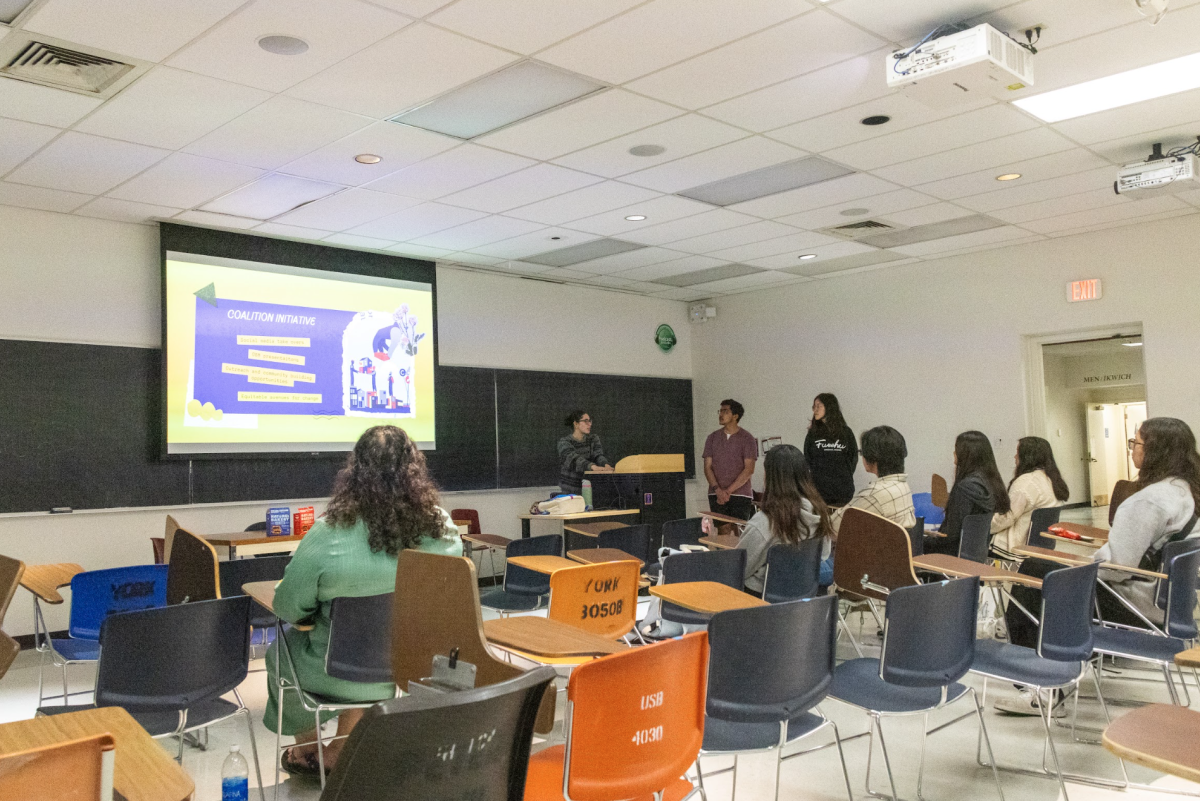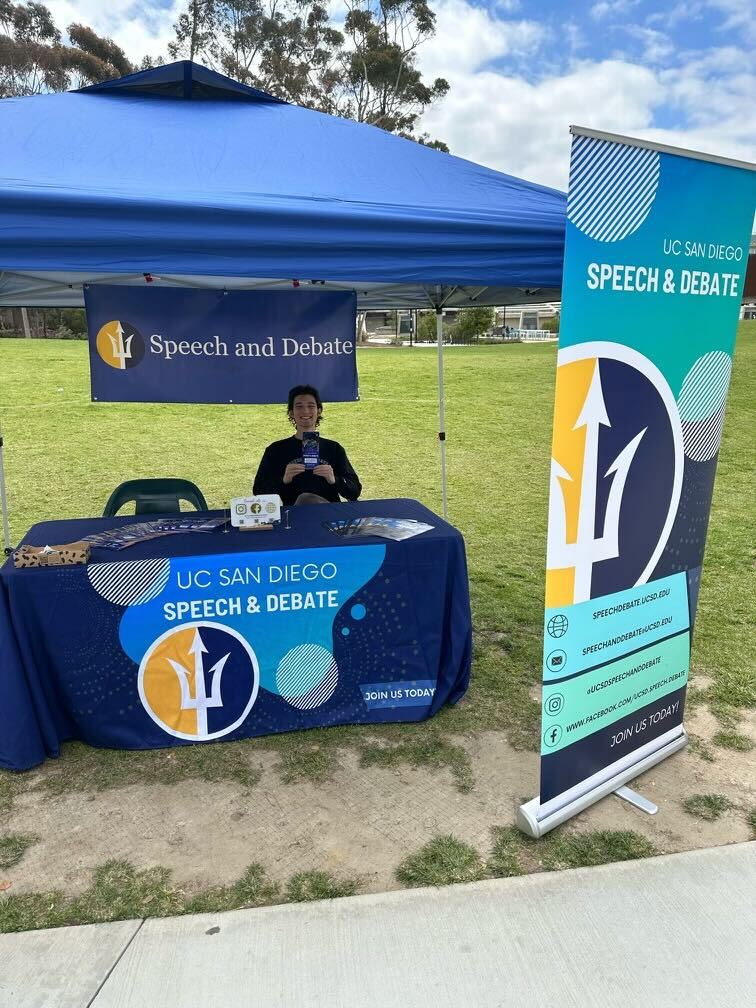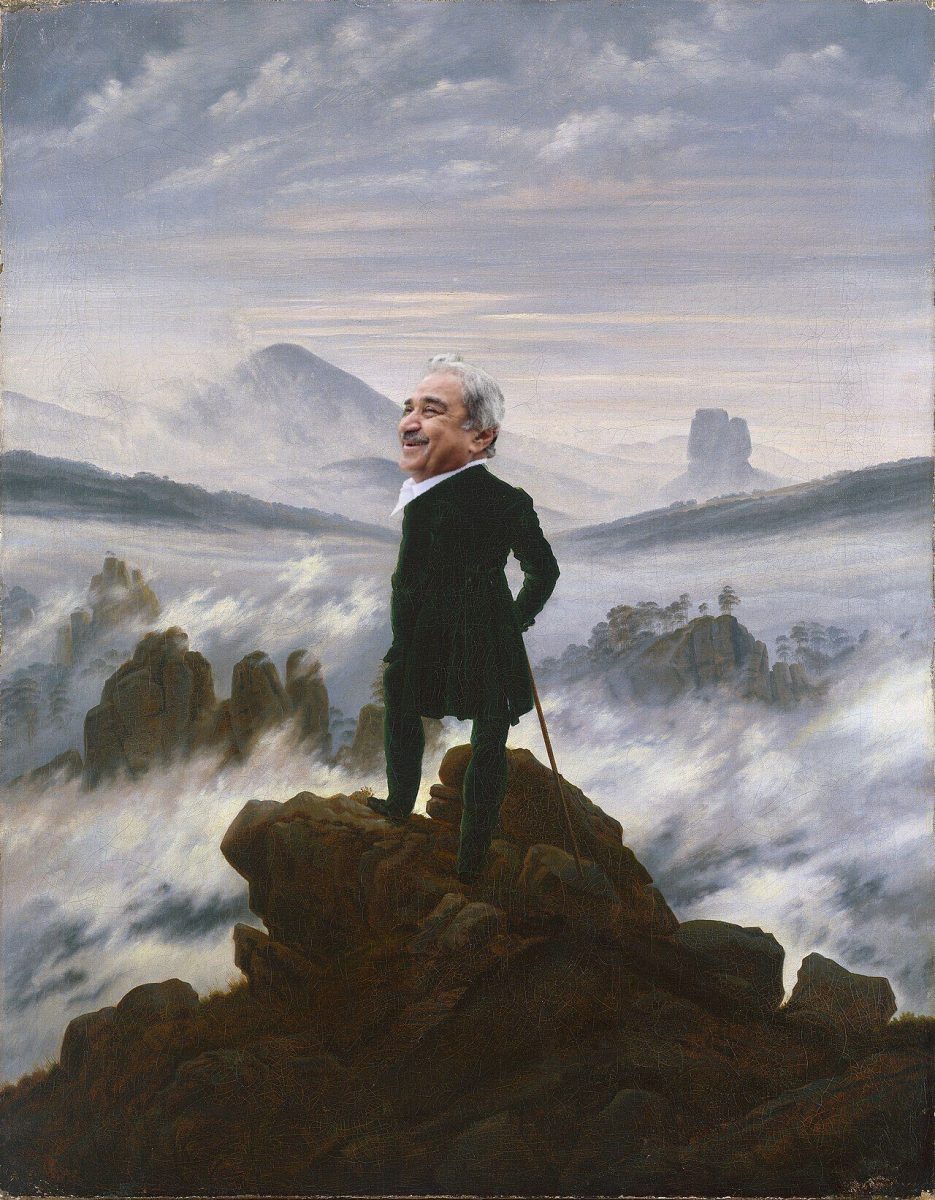
With the NCAA Division-I referendum looming and tensions defining campus climate, Spirit Night presents a vision of a school with more school spirit than we have. The UCSD Guardian polled students and interviewed members of Pep Band, Tritons Rising, ICRA and athletics to get to the issues behind the blue and yellow face paint.
The buzzer rings then there is the distinctive swish of the basketball net. The crowd erupts into shouts and flashes of yellow as the men’s basketball team scores another three-pointer. At one end of the court, a conglomeration of athletes, Greeks, organizations and dancers chant the name of our school over and over again, echoing louder than the call of a time-out. Briefly, they sport a sign that says, “This is what Div-1 looks like” in glitter paint. At the other end of the court, the Pep Band, dressed in Hawaiian attire, blasts an arrangement while dancing.
Muir College sophomore Chris Gross, co-conductor of the Pep Band, sports a coconut bra and grass skirt just as he had promised the UCSD Guardian a day before when he sat down to talk about Pep Band and school spirit in general.
“You will have the audience and they will be dead or quiet,” Gross told the Guardian outside of Starbucks. “When we play a song it gets the crowd more into it, it uplifts the atmosphere. I will look over and some of the crowd members look more into it [the game] … I wish people had more school spirit, which is what pep band tries to provide.”
Despite the large turnout for Spirit Night this past Friday and the musical efforts of the Pep Band, according to a poll run by the Guardian, school spirit is overall poor. Over 100 anonymous students rated UCSD spirit at a 1.9 out of five. However, college school spirit was higher than the overall university, averaging 2.2 out of five.
Although the numbers look bad, some responders didn’t view school spirit as a valid problem.
“I don’t think we need to improve school spirit,” one responder noted. “UCSD is an atypical college experience and I knew that when I signed up to come here. I think it’s one of the things that makes us special. Our atmosphere isn’t college-y.”
Others saw the issue in the opposite light.
“It’s superficial spirit,” a passionate responder pointed out. “Every damn event is organized top-down, never middle or even bottom-up. Yes, on occasion RAs host small events, and my college will give me a free sandwich and a brochure, but that’s it. The climate remains focused on constantly working and studying. It’s hard to articulate how fucked this school is in that; all of what I just typed is fragments but it’s infuriating to think about.”
Although there appears to be no agreement, the voices of the latter echo louder than the former in debates over campus climate. Amid this, a referendum to move athletic standing from Division II to Division I will be decided on by A.S. Council this coming Wednesday. The change could offer a bandage for hemorrhaging morale and bring us to the level of our UC competitors according to A.S. Council President Dominick Suvonnasupa.
“We compete with Cal and [UCLA] academically in a lot fields and best them in some fields, [which is] amazing considering we’re much younger than they are,” Suvonnasupa told the Guardian. “I think what Division I would do is let us catch up to them in other ways.”
When asked what students and the university could do to increase the school spirit, 35 percent of those who answered supported the change.
“[Becoming] a Division-One NCAA institution is the key to improving both spirit and school visibility,” one student said. “As much as I loathe football and its following, I think bringing the sport would promote more camaraderie for UCSD and more degree and school recognition.”
Camaraderie through athletics is what Tritons Rising, a new student organization supported by the Department of Athletics, is dedicated to promoting. During one of their events to promote Spirit Night, we talked with Muir junior Omid Tabatabai, a founding member of Tritons Rising.
After handing out hundreds of bright yellow shirts, Tabatabai commented that by supporting athletics we can help reduce stress and build pride in our school.
“Personally, I feel that we are distracted by administration and tensions in the world, not just UCSD,” Tabatai told the Guardian. “More school spirit and going to games could help students take their mind off it; it takes a small few to get the movement going and it can make a difference at the games. Honestly, it’s a fun time. Even if you don’t know what’s going on, you can still feel a part of it.”
According to the Guardian’s poll, UCSD students on average only attend 1.2 games per quarter. Although many had been to multiple games ranging from four to six, over fifty percent of responders do not attend any games per quarter. However efforts by Tritons Rising and individual college spirit groups seem to be working. With 3,924 fans at the men’s game last friday marked the highest attendance since 2008. Tabatabai commented that the organization is trying in increase attendance and interest.
“On campus, it’s hard to get people out to games; we do try to incentivize but you have to be patient and preserve,” Tabatabai said.
Looking at the Guardian survey, giving students incentives means spicing up school events with free food, tailgates, and one even commented a “t-shirt cannon would be dank.”
Incentives aren’t just free stuff, but also events that appeal to students’ natural sense of competition. Just like the Spirit Night Competition, where each college competes for the Spirit Night Trophy, students recommended more rivalry. The competition brings out many of the students who normally would not attend. Sophomore ERC Student Council Member Alison Wong helped lead her college to victory on Friday.
“Student spirit on campus is usually very quiet, but during Spirit Week it is definitely amped up,” Wong told the Guardian. “Especially during the game it is very apparent that UCSD students have spirit in their hearts and come together as one because we are very competitive.”
Students often identify more with their college than with the school overall, as shown by the higher rating of college spirit than university spirit. Pitting the six colleges against each other increases college pride but it’s hard to say what it does for the overall university.
While tabling for the Spirit Night Dance, two members of the Inter-College Resident Association, which funds specific college events and all-campus events, examined the six college system and its pitfalls.
Sixth College sophomore Nathan Tong noted the irony implicit in holding competitions between the six groups.
“Although on the [Spirit Night] website it does say they try to unify the UCSD as one … the colleges are split,” Tong noted. “Maybe we shouldn’t emphasize the six college system so much. Everytime I meet someone the first question I ask is ‘what college are you from?’. Maybe we need to change that atmosphere.”
Roosevelt College senior Claudia Walukouw agreed with her fellow ICRA member but expressed hope that UCSD spirit can be improved.
“It’s difficult to bring everyone together but it’s doable, it just takes events like the Spirit Night dance,” Walukouw said. “It is hard because It’s not just the six colleges but also International House and the village, which is a huge community that people ignore when it comes to college based events.”
It’s nearly impossible to predict what, if anything, would happen to the individual colleges we call home if we switch to Division I; a house divided against itself cannot stand. Balancing healthy rivalry between the six colleges and increasing university wide spirit to support Division I teams provides a unique challenge.
Of course the move has huge implications for all areas of student life, not just athletics.
“I think the students need to know the pros and the cons,” Tabatabai said. “When the vote goes out in spring, read the whole thing. Know the fees that go with it, but also know that it could make a more fun and spirited campus.”
The move is in itself a gamble which is part of the reason that 60 percent of students voted against the change in spring of 2012. However, many of our teams already play at a Division-I level such as water polo, fencing and volleyball. A change of division would allow them to recruit more students with more funding. Of course this comes with three years of consecutive fee increases starting at $60, $55 then $45 on top of the current fee of $129.38. Tallied up with inflation it totals to $302.22 in 2018. And this guarantees nothing — voting for the fee increase only goes into place if we are accepted into a NCAA Division-One conference. The Big West Conference, the conference of many of our neighbors such as UCI and UCSB, or another group must first accept UCSD.
Sixth College Senior Lauren Finwall who plays for our nationally ranked waterpolo team emphasized that supporting athletics is supporting UCSD.
“Moving to D1 not only benefits athletics but also the student body as a whole,” Finwall told the Guardian. “We will grow and thrive from this movement by gaining more recognition not only within the UC system but also in the nation, making us more competitive.”
Whether the answer is a switch to Division One, a t-shirt cannon or more college competitions, it’s clear that we need change if we want to raise UCSD spirit. Our decisions will decide if next year’s Spirit Night will be an anomaly or a normality.







